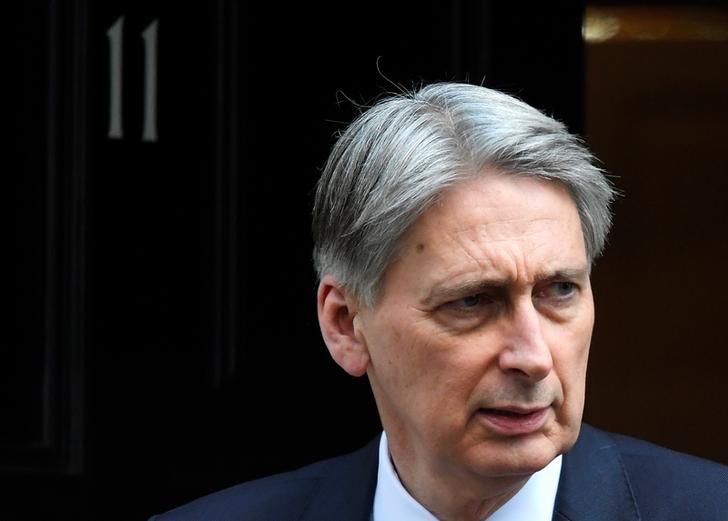 © Reuters. Britain’s Chancellor of the Exchequer Philip Hammond, leaves 11 Downing Street in London
© Reuters. Britain’s Chancellor of the Exchequer Philip Hammond, leaves 11 Downing Street in LondonLONDON, (Reuters) – British finance minister Philip Hammond met his target for cutting the country’s budget deficit in the recently ended 2017/18 financial year, according to official data published on Tuesday.
The deficit for the 12 months to the end of March stood at 42.6 billion pounds, excluding state-controlled banks, its smallest since 2006/07 and nearly 8 percent smaller than in the previous tax year.
The shortfall between how much the government spends and how much it earns from tax revenues was below the 45.2 billion pounds forecast by Britain’s budget watchdog last month.
It was comfortably under the watchdog’s previous forecast of just under 50 billion pounds, set in November.
Hammond has made fixing the public finances his priority although he has taken a slower approach than previous finance minister George Osborne who inherited a deficit equivalent to just under 10 percent of gross domestic product in 2010.
Tuesday’s figures showed the shortfall narrowed to 2.1 percent of GDP in the most recent financial year.
The current budget, which measures day-to-day spending by the government, showed a small surplus in the 2017/18 year, its first since 2001/02.
In March alone, the full budget deficit stood at 1.3 billion pounds, nearly 37 percent smaller than in the same month last year, the Office for National Statistics said.
The shortfall was also smaller than a median forecast of 3.25 billion pounds in a Reuters poll of economists.
Public debt stood at 1.798 trillion pounds, or 86.3 percent of GDP, up from 85.3 percent of GDP in the previous financial year and about double its level before the financial crisis.
The headline public sector net debt figures are currently inflated the effect of a temporary Bank of England lending scheme introduced after the Brexit vote.
Hammond has set himself a target of cutting debt as a share of GDP each year from the 2018/19 financial year which began this month – something which is a near certainty due to the impending reversal of the BoE scheme.
Stripping out the effect of the BoE scheme, net debt as a share of GDP is already falling.
Hammond has made more progress than expected on improving the public finances because Britain’s economy slowed less than feared after the 2016 Brexit referendum shock.
However, Hammond says Britain will continue to spend and invest more than it raises from taxation until the mid-2020s.
He faces tough choices in the coming years after promising to relax his grip on public pay at a time when he is also facing calls to spend more on health and other services.
However, Hammond has suggested he could announce more spending in his budget in November.
Tuesday’s figures showed revenues from income tax and capital gains rose by 6.1 percent in March compared with the same month last year while corporation tax revenues were up by 2.2 percent.
Debt interest payments fell by 75 percent in March but were up by more than 12 percent in the full financial year.
Rising inflation pushed up the amount the government pays out in debt interest payments. Around a third of British government bonds are linked to inflation.
Fusion Media or anyone involved with Fusion Media will not accept any liability for loss or damage as a result of reliance on the information including data, quotes, charts and buy/sell signals contained within this website. Please be fully informed regarding the risks and costs associated with trading the financial markets, it is one of the riskiest investment forms possible.
Source: Investing.com




























